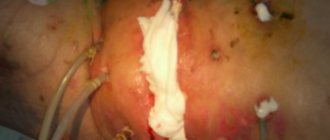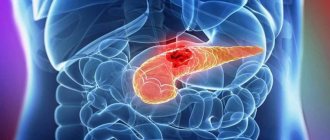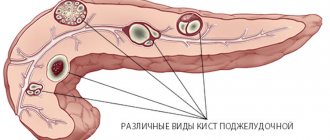Among all diseases of the gastrointestinal tract (GIT), the incidence of chronic pancreatitis ranges from 5.1 to 9%, and in the last few decades, the incidence of pancreatitis in our country has doubled1.
Chronic pancreatitis is an insidious disease, largely due to its recurrent nature. Patients are often concerned about periods of exacerbation, accompanied by severe pain, nausea, and vomiting.
Where does chronic pancreatitis come from? What causes the disease and is it possible to fight it? Let's try to figure it out.
Symptoms of chronic pancreatitis
Symptoms of chronic pancreatitis may vary depending on the stage (remission or exacerbation), course and physical condition of the patient. The main signs of the disease are as follows:
- acute pain without clear localization. Pain can be felt in the right hypochondrium, upper or middle abdomen and spread to the back. In many patients, pain occurs immediately after eating, especially if the diet contained fatty, smoked or spicy foods;
- frequent loose stools are one of the main signs of indigestion. Digestive problems in chronic pancreatitis are caused by a lack of enzymes;
- heaviness in the abdomen, nausea, which also indicate a lack of digestive enzymes;
- increasing feeling of hunger, muscle tremors, weakness, cold sweat;
- intoxication, manifested in fever, chronic fatigue, and a feeling of general malaise.
Pancreatitis in children
In young children, pancreatitis is usually a consequence of congenital malformations of the digestive system or enzyme deficiency. It can also be a complication of mumps (mumps). In older children, the development of the disease may be associated with poor nutrition (including abuse of sweets and carbonated drinks) or caused by intestinal parasites.
Children are often unable to clearly formulate their complaints, what and how they hurt. Therefore, at the first signs of the disease (the child’s complaints of abdominal pain, nausea, vomiting, unstable stool with impurities of undigested food), you should immediately consult a doctor. Infants with pancreatitis cry hysterically and quickly lose weight. Their tummy is swollen.
It is necessary to diagnose the disease promptly and begin treatment to prevent loss of the pancreas.
More information about pancreatitis in children
Causes of chronic pancreatitis
One of the most common causes of chronic pancreatitis is poor diet and unhealthy lifestyle. Constant overeating, abuse of fatty foods and alcohol cause blockage of the excretory ducts of the pancreas.
Narrowed excretory ducts provoke the accumulation and premature activation of digestive enzymes. As a result, the pancreas actually begins to digest itself, and inflammation forms1.
In addition, the following factors can lead to chronic pancreatitis3:
- ulcer of the duodenum, stomach and enteritis. Chronic inflammation of the mucous membrane of the gastrointestinal tract makes it difficult to secrete pancreatic juice, which often causes chronic pancreatitis;
- cholelithiasis. After leaving the gallbladder, the stone causes blockage of the common duct and inflammation of the pancreas develops;
- genetic predisposition;
- toxic effects of drugs.
Pancreatic diseases
The digestion process is impossible without pancreatic juice, which is produced in the pancreas. It has 3 sections - head, body, tail. This gland has a complex structure, and the functions of the organ are very important. Its secretion is involved in the breakdown of proteins, fats, carbohydrates, and it produces the hormones glucagon and insulin.
When the functions of the gland are impaired, serious diseases develop, the most common of which are:
- pancreatitis (acute and chronic);
- autoimmune pancreatitis;
- pancreatic necrosis;
- cyst;
- stones;
- cancer.
The functioning of the organ affects energy metabolism; these diseases can lead to diabetes.
Diagnosis of chronic pancreatitis
Identifying chronic pancreatitis can be difficult due to the nonspecific clinical picture. Nausea, abdominal pain, digestive problems - these symptoms are characteristic of many diseases, for example, stomach ulcers or chronic cholecystitis. Therefore, identifying the disease may require a whole range of studies. Diagnosis of chronic pancreatitis may include2,3:
- external examination of the patient. Chronic pancreatitis may be indicated by bluish areas of the skin on the front and side walls of the abdomen. In some patients, bright red patches of skin on the chest and back become noticeable. Palpation may reveal pain in the left hypochondrium and the upper third of the abdomen;
- a general and detailed blood test, which shows the presence of an inflammatory process, based on an increase in the concentration of leukocytes;
- laboratory blood test to identify markers of nutritional status;
- fecal elastase test;
- ultrasonography. In some cases, ultrasound examination (ultrasound) can be performed through the walls of the stomach and duodenum, which significantly increases the accuracy of the examination. This method is called endoUS and combines the possibility of endoscopic and ultrasound diagnostics of the gastrointestinal tract (GIT);
- computed tomography: used to determine complications of pancreatitis associated with thickening of the pancreas tissue.
What is pancreatitis
Pancreatitis is inflammation of the pancreas. This organ secretes enzymes into the duodenum (just behind the stomach) that help food digest, such as amylase (to break down carbohydrates) and lipase (to break down fats). With severe inflammation of the pancreas - acute pancreatitis - its cells are destroyed and enzymes enter the blood. Therefore, for any severe abdominal pain, doctors determine the level of amylase in the blood.
Acute pancreatitis is a painful and very dangerous disease. Its symptoms are almost impossible to endure “on your feet”: it is a severe, persistent pain in the pit of the stomach and under the left rib, which often radiates to the back (so-called girdling pain occurs). A person with acute pancreatitis often even takes a special position on the bed - lying on his left side, so as not to increase the pain by moving the ribs when breathing. Most people with acute pancreatitis experience severe nausea and vomiting; any food intake increases the pain: after all, the pancreas begins to secrete enzymes when eating, and this increases blood flow, and therefore pain. Many people's body temperature rises.
Diagnosis of acute pancreatitis is the job not so much of gastroenterologists as of surgeons, since the intensity of pain can be the same as with appendicitis and other “surgical” pathologies.
Exacerbation of chronic pancreatitis
Chronic pancreatitis may hardly manifest itself until the period of exacerbation. Relapse of the disease is usually associated with two main reasons3:
- alcohol consumption. Even a small amount of alcohol consumed can provoke the transition of the disease into the acute phase;
- violation of the diet, overeating, a large number of fatty, fried, spicy dishes on the menu.
Other factors can also provoke exacerbation of chronic pancreatitis in adults, for example, chronic stress, physical fatigue, poisoning or the toxic effects of certain medications3.
Exacerbation of the disease is manifested by the following symptoms3:
- attack of acute or dull pain in the hypochondrium. Painful sensations spread to the subscapular region or the entire back;
- progressive diarrhea. In this case, the feces have a characteristic greasy shine. Undigested food remains are often observed in the stool;
- the occurrence of specific bitterness in the oral cavity, nausea and loss of appetite;
- whitish coating on the surface of the tongue;
- weight loss.
Exacerbation of chronic pancreatitis in adults can last for one to two weeks. You cannot fight the disease on your own during this period: the best solution is hospitalization and constant monitoring by specialists.
Acute pancreatitis: treatment and first aid
When initial symptoms of the disease appear, you must call an ambulance. Treatment of acute pancreatitis takes place exclusively in a hospital setting under the constant supervision of specialists.
While waiting for doctors, to alleviate the patient’s condition, you can put cold on his stomach. As for medications, you can take any antispasmodics - papaverine, no-shpu, smazmalgon, etc. From the moment the first symptoms appear, you should stop any food intake (including juices) and go to bed. Doctors say that no medicine treats pancreatitis better than cold, hunger and rest.
Treatment in a hospital is carried out taking into account the clinic. Antispasmodics, prokinetics, anti-inflammatory drugs, antisecretory, antibacterial drugs are used (for the prevention or treatment of bacterial complications). Treatment is carried out by infusion (through a dropper). Diet therapy (when the patient is allowed to resume eating) is of great importance. Enzyme preparations are used during meals.
Treatment of chronic pancreatitis
The answer to the question “how to cure chronic pancreatitis” remains open even for modern doctors. The treatment regimen is determined by the doctor for each individual case. The main thing is that therapy should be comprehensive, affecting the main cause of the disease.
Treatment of chronic pancreatitis includes2,3,4:
- immediate cessation of bad habits. Smoking and abuse of strong alcoholic beverages aggravate the inflammatory process and contribute to the subsequent development of the disease;
- strict adherence to the diet. The daily diet should contain high-calorie foods, without spicy foods, salt and pure sugar. You should eat food often, in small portions. In case of exacerbation of chronic pancreatitis, therapeutic fasting is prescribed, which will help stop pancreatic secretion and relieve pain. After 1-3 “hungry” days, the patient is transferred to a special diet;
- basic therapy. In this case, we are talking about taking the following type of drugs: antispasmodics and analgesics, antisecretory and detoxification drugs. Treatment is carried out under the supervision of a doctor with strict adherence to the instructions;
- taking enzyme preparations, the task of which is to compensate for the impaired functioning of the pancreas. The fact is that the pancreas does not recover (it is not the liver), and therefore will no longer be able to work at full capacity during chronic pancreatitis. That is why the first line of therapy is enzyme preparations, which should be taken for life. An example of an enzyme drug prescribed for chronic pancreatitis is Creon®;
- complex therapy. May include taking antispasmodics or analgesics, antisecretory and detoxification medications. Therapy is carried out under the supervision of a physician with strict adherence to the instructions;
- taking anti-inflammatory and painkillers that improve the patient’s well-being;
- herbal medicine, which can be prescribed during remission only as prescribed by a doctor.
What to do if an exacerbation of pancreatitis occurs suddenly, and the ambulance has not yet arrived? Before the doctors arrive, you need to lie down, try to relax your abdominal muscles as much as possible and apply a heating pad with cold water to the sore spot. You should not take painkillers or any other medications - this will interfere with correct diagnosis. And, of course, any food and drinks, even plain water, are strictly prohibited, because any food or liquid can cause increased pain3.
Treatment of male pancreatitis
After a comprehensive examination, treatment is prescribed aimed at eliminating the causes of the pathology, restoring the gland and preventing complications. Therapy is carried out conservatively or surgically. In the first case, medications are used to relieve pain, eliminate inflammation, and detoxify. In acute cases, complete fasting for several days is recommended. Indications for surgical intervention may include purulent processes, cysts, stones in the bile ducts, and areas of pancreatic necrosis.
Make an appointment with a gastroenterologist
As soon as men experience the first symptoms of pancreatitis, it is recommended to immediately seek medical help. Ardenium clinic specialists are ready to conduct a thorough examination of the patient and prescribe treatment, taking into account the form and severity of the pathology. Our center employs doctors of the highest category who regularly train abroad and improve their skills in specialized courses. To diagnose the disease, new generation equipment is used, which makes it possible to make a diagnosis with high accuracy.
To make an appointment with a gastroenterologist, use the contact form or call us at (3412) 52-50-50. We guarantee effective and efficient treatment even for complex forms of pancreatitis!
The drug Creon® 25000 for chronic pancreatitis
Find out more
Decreased pancreatic function inevitably leads to a lack of digestive enzymes in the body, so-called enzyme deficiency. As a result, the quality of digestion suffers, and the body does not receive the necessary energy and nutrients for full functioning. Creon® is designed specifically to compensate for the lack of its own enzymes through their delivery from the outside and belongs to the group of enzyme preparations. The drug contains enzymes identical to those produced by the pancreas. The key feature is that the active ingredient Creon® is small particles - minimicrospheres, which are collected in a capsule. The fact is that science has been studying enzyme preparations for more than 100 years in order to increase their effectiveness. To date, scientific advances indicate that preparations with particles whose size does not exceed 2 mm4.5 can most accurately recreate the natural process of digestion. Moreover, it has been scientifically proven that the smaller the particles of the drug, the more effective it can be4,6.
Creon® is the only drug whose capsule contains hundreds of small particles - minimicrospheres7. Their size does not exceed 2 mm, which is recorded as recommended in world and Russian scientific works4,5,6.
Clinical manifestations
The acute form is characterized by severe girdling pain radiating to the left scapula and collarbone, vomiting that does not bring relief, dizziness, tachycardia, weakness, and stool disturbances. The temperature depends on the stage of pancreatitis. If in the first two days it is normal (with the exception of acute cholangiopancreatitis and cholecystopancreatitis), then from the third it increases. Characteristic symptoms of the disease are bluish spots throughout the body. The reason is circulation problems.
There are four stages of acute pancreatitis: enzymatic, reactive, period of purulent complications and outcome.
Enzymatic (early) lasts the first five days. Characterized by severe symptoms of intoxication.
Reactive begins on the 7th day of the disease and lasts 7-10 days. Manifested by fever and gastric symptoms.
Period of purulent complications. Foci of necrosis of the gland become infected and the bacterial process spreads to neighboring organs. Possible bleeding.
Outcome: for a mild form, recovery from inflammation takes 3 weeks, for a severe form it takes from a month to two.
Medicines for pancreatitis are prescribed exclusively by a doctor. Self-medication can be fatal.
What else is important to know about enzyme preparations?
The minimum starting dosage is Creon® 25,000 units, which is stated in Russian recommendations for the treatment of chronic pancreatitis and exocrine pancreatic insufficiency2,5. The number indicates the amount of the enzyme lipase, which helps digest fats. If necessary, the doctor can increase the dosage; in European practice, the required dose per single dose can reach up to 80,000 units8. By comparison, the pancreas of a healthy person produces up to 720,000 of these units during each meal9.
Therapy should be taken seriously, since high-quality “nutrition” of the body is the key to its functioning. How long can a person live without energy from food? With chronic pancreatitis, the body must be supplied with enzymes at every meal, even with a snack. Thus, in accordance with the instructions for the drug Creon®, a full dose is required for a meal (for example, 25,000 units), and half for a snack. Creon® capsules are convenient to use: you can open them and add minimicrospheres to food, thereby selecting the desired dose10. More information about the admission rules can be found here.
Toxic (drug-induced) pancreatitis
Drug-induced pancreatitis occurs in less than 5% of cases. The prognosis for this pancreatitis is generally good and the mortality rate is low. The pathogenetic mechanism of drug-induced pancreatitis includes:
- immunological reactions (6-mercaptopurine, aminosalicylates, sulfonamides);
- direct toxic effects (diuretics, sulfonamides);
- accumulation of toxic metabolites (valproic acid, didanosine, pentamidine, tetracycline), ischemia (diuretics, estrogens);
- increased viscosity of pancreatic juice (diuretics and steroids).
Demonstrating interactions between pancreatitis and drugs is usually difficult. Pancreatitis may develop within a few weeks of starting treatment. Rash and eosinophilia may occur. Meanwhile, patients taking valproic acid, pentamidine or didanosine do not develop pancreatitis until many months later due to chronic accumulation of the drug's metabolite.
When restarting treatment, patients should be closely monitored. If symptoms recur, the drug should be discontinued.
Diagnosis of the disease
Diagnosis is carried out only in a clinical setting - the patient initially consults a therapist. During the examination, the doctor clarifies the complaints and prescribes a number of procedures:
- blood test (general and biochemical);
- Analysis of urine;
- stool analysis with determination of fat content;
- radiology diagnostics;
- linked immunosorbent assay;
- collection of pancreatic secretions through a probe (inserted directly through the esophagus);
- secretin-pancreozymin test;
- Lund's method eliminates the insertion of a probe, but is not as effective and is therefore used much less frequently.
Treatment
Treatment of acute pancreatitis is carried out in the surgical department. In this case, the treatment regimen is strictly individual and depends on the cause of acute pancreatitis, stage, clinical manifestations and condition of the patient.
Drug treatment:
- pain relief (intravenous analgesics, novocaine blockade);
- drugs that improve microcirculation (hemodez, reopolyglucin);
- medications to reduce the production of pancreatic enzymes (contrical, gordox);
- drugs to restore electrolyte loss;
- antibacterial drugs (metronidazole, ciprofloxacin).
Particular attention should be paid to the diet in acute pancreatitis of the pancreas.
If the disease has progressed to the stage of purulent complications, surgical treatment is recommended. The operation is performed under general anesthesia.
Diagnosis of exacerbation of pancreatitis
Diagnosis is based on clinical manifestations, laboratory results and additional examination methods.
Symptoms: severe girdling pain, uncontrollable vomiting, tachycardia, bowel movements, weakness, bloating.
Laboratory studies show the following. Complete blood count - an increase in the number of leukocytes, an increase in the erythrocyte sedimentation rate and a decrease in hematocrit. Biochemistry - a sharp increase in amylase and lipase, a decrease in total protein, an increase in urea, a decrease in the levels of calcium, potassium and sodium. Urinalysis - increased amylase. Please note that a blood test if you suspect an attack of pancreatitis is very important.
Sometimes additional examinations are needed. Ultrasound of the pancreas - enlargement of the gland, uneven contours, heterogeneity of echogenicity. MRI – presence of foci of necrosis and ischemia. Additional methods for diagnosing exacerbation of pancreatitis also include computed tomography, x-ray and diagnostic laparoscopy.
On our website you will find more detailed information. You can make an appointment at the clinic using one of the numbers at a time convenient for you. Our doctors will help you decide on research methods and tell you what to do during an attack of acute pancreatitis.









